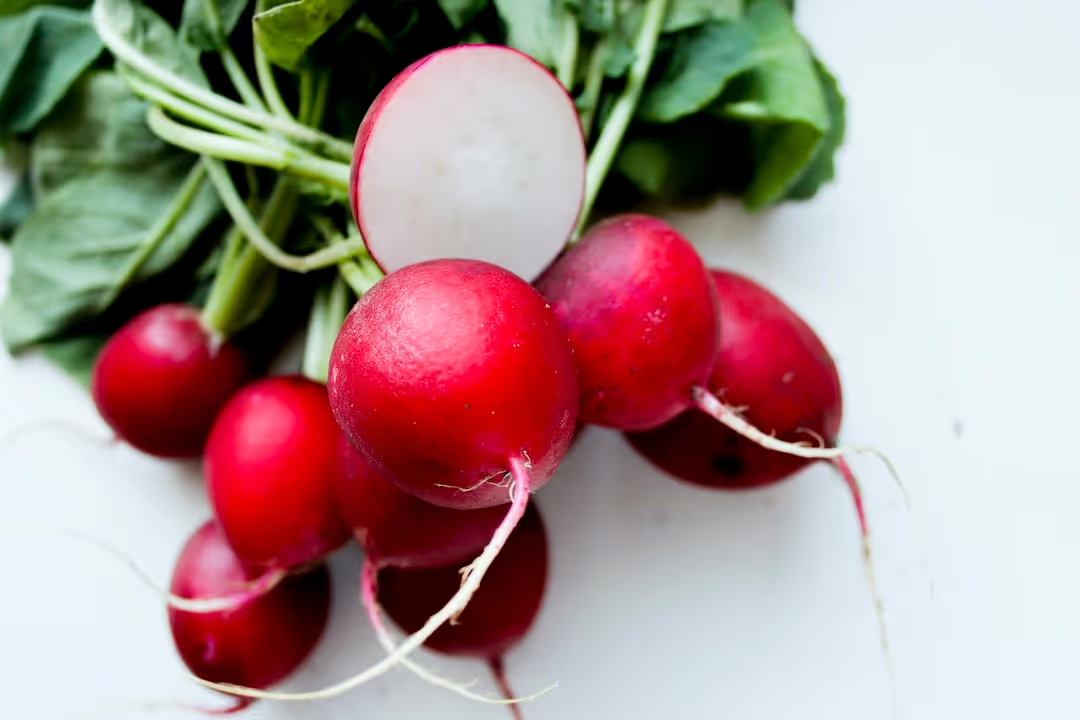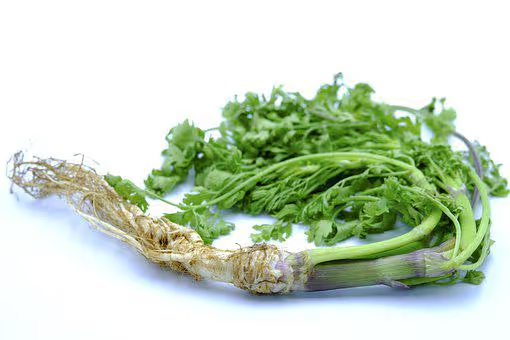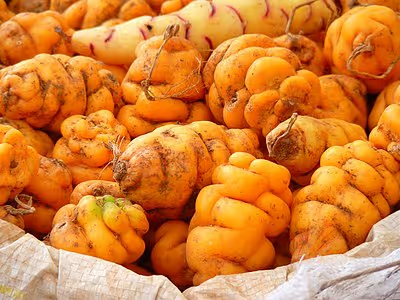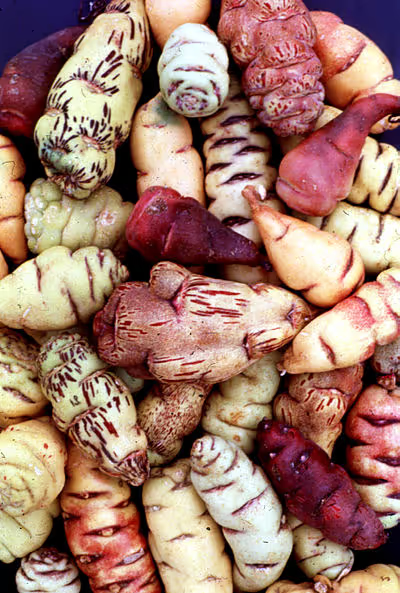Growing Radish: Simple Steps for Fresh, Crunchy Harvests

Growing Radish
Growing radish offers quick gratification—plant seeds today, harvest crunchy roots in as little as four weeks. Short on garden space? Growing radish in containers or compact beds makes this cool-season crop an easy win. With sharp flavors, vibrant colors, and almost foolproof cultivation, radishes earn their keep; read on to nail every detail from sowing to snacking.
Cheatsheet: Radish Harvests Made Easy
🌱 Radish Fast Facts
- 18–30 days from seed to harvest
- Packed with vitamin C, fiber, potassium
- Grows year-round in cool temps: 50–70°F / 10–21°C
🧰 Tools and Products You'll Need
- Hand trowel
- Watering can or hose
- Rake
- Measuring tape
- Radish seeds
- Compost
- Fine mulch (optional)
📍 Best Location & Soil
- Full sun (6+ hrs/day)
- Loose, well-draining soil, pH 6–7
- Mix in compost before planting
📏 Sowing
- Sow ½ in / 1.25 cm deep
- 1 in / 2.5 cm apart in rows
- Space rows 8 in / 20 cm apart
- Direct sow outdoors; avoid transplanting
💧 Water & Care
- Keep soil evenly moist
- Thin to 2 in / 5 cm apart after sprouting
- Mulch lightly to hold moisture
- Too dry: roots turn woody
✂️ Harvest
- Harvest at ¾-1 in / 2-2.5 cm diameter
- Pull gently—roots bruise easily
- Store leaves and roots separately
🥗 Nutrition & Use
- Low-calorie snack, rich in antioxidants
- Great for salads, pickles, sandwiches
- Leaves are edible—sauté or blend
🔄 Succession Planting
- Resow every 1–2 weeks for steady supply
- Yields up to 5 lbs / 2.3 kg per 10 ft / 3 m row
Smooth soil, mix in compost, clear stones. Choose full sun.
Plant seeds ½ in / 1.25 cm deep, 1 in / 2.5 cm apart.
Keep moist, thin to 2 in / 5 cm apart when 2 in / 5 cm tall.
Harvest when roots reach ¾-1 in / 2-2.5 cm diameter (18–30 days).
-
Growing Radish: Simple Steps for Fresh, Crunchy Harvests
I plant Growing Radish runs like an impatient cook times a soft-boiled egg. I want speed, bite, and crisp texture, and radishes deliver if I set the table right.
Timing and temperature
Sow when soil hits 45 to 50 F, 7 to 10 C, and is workable. They surge in cool weather, with fastest growth around 55 to 70 F, 13 to 21 C.
“Radishes can be ready to harvest in as little as four weeks.” — Royal Horticultural Society
I sow every 7 to 10 days in spring and again in late summer. Heat shortens tempers and roots, so I pause during sustained 80 F, 27 C, spells.
Site and soil
Full sun grows sweeter, denser roots, though light shade during heat helps. Aim for a loose, friable bed with pH 6.0 to 7.0.
I mix in finished compost for tilth, then go easy on nitrogen. Too much N pumps leaves and leaves roots hollow.
A gentle pre-plant feed like 5-10-10 at 1 to 2 pounds per 100 square feet, 0.5 to 1 kg per 10 square meters, treats them kindly.
Sowing that clicks every time
- Depth: 0.5 inch, 1.2 cm, into moist soil.
- Spacing: sow thick, then thin to 1 inch, 2.5 cm, for small types or 2 inches, 5 cm, for chunkier roots.
- Row spacing: 6 to 8 inches, 15 to 20 cm, or a 4 to 6 inch, 10 to 15 cm, grid in square-foot beds.
- Succession: re-sow weekly for a steady stream.
- Cover: lay light row cover immediately to stop flea beetles from shot-holing the leaves.
I often use seed tape or pelleted seed for razor-clean rows in containers. It saves thinning time on busy weeks.
Water and feeding
Even moisture keeps texture crisp and flavor balanced. I target 1 inch, 25 mm, a week total, split into light, frequent drinks in sandy beds.
Dry-wet swings turn roots hot and pithy. A thin mulch of washed compost or straw evens things out.
Thinning: the make-or-break move
I thin the moment true leaves appear. Delay, and you get threadlike roots wrestling under crusted soil.
I eat the thinnings in buttered toasts with salt. Waste nothing, harvest earlier.
Harvest and storage
I start tug tests at 20 days for quick varieties. Pull when shoulders show and roots hit 0.75 to 1 inch, 2 to 2.5 cm, across for spring types.
Twist off tops, bag unwashed roots, and store at 34 to 38 F, 1 to 3 C, high humidity. They stay snappy for a week or two.
Heat, bolting, and off flavors
Heat above 80 F, 27 C, and long days cue bolting and hollow cores. I use 30 percent shade cloth on hot afternoons and water in the morning.
If you spot pithiness, you waited too long or water ran short. Pull and re-sow rather than hope.
Varieties worth your time
- Cherry Belle, 22 to 25 days: round, mild, classic market crunch.
- French Breakfast, 25 to 30 days: elongated, crisp, peppery finish.
- Easter Egg mix, 25 to 30 days: color party, similar timing, great for kids and CSA boxes.
- Watermelon, Mantanghong, 55 to 65 days: green-white skin, neon rose heart, best in cool fall soils.
- Daikon Minowase, 55 to 70 days: long white storage root, needs 12 inch, 30 cm, of depth.
- Green Luobo, 55 to 65 days: emerald flesh, nutty-sweet, top-tier for pickles.
- Black Spanish, 55 to 70 days: dense, spicy, stores for months.
- Sakurajima, giant type, 90 to 120 days: for deep raised beds and bragging rights.
I rotate two fast spring types and one winter keeper each year. That keeps plates interesting and beds healthy.
Containers and tight spaces
Use a pot at least 6 inches, 15 cm, deep for spring radish, 12 inches, 30 cm, for daikon. A peat-free, well-drained mix with 20 percent coarse perlite prevents forked roots.
Bottom water to keep leaves clean. I still cover with insect netting to dodge flea beetles on balconies.
Pests and problems
Flea beetles: protect with row cover from sowing to harvest. If pressure spikes, I switch to finer insect netting and keep weeds down around the bed.
Cabbage maggot: avoid spring sowing during peak fly emergence, use row cover, and skip fresh manures that attract egg laying. Beneficial nematodes help in persistent sites.
Clubroot: rotate all brassicas 3 to 4 years and raise pH to near 7.2 with lime where soil is acidic. I sanitize tools after wet harvests in infected beds.
Forked roots come from stones or fresh manure. I screen bed soil once and feed modestly.
Companions and clever pairings
I intercrop radish with carrots as a living row marker. Radishes finish before carrots need the space.
As a trap crop near bok choy and kale, radish takes the hit from flea beetles. I remove chewed leaves and re-sow outside the main brassica block.
Winter types and storage tricks
Sow winter radishes 6 to 8 weeks before first frost, often late August to early September for temperate gardens. They bulk best as nights cool to 40 to 55 F, 4 to 13 C.
Store at 32 F, 0 C, and 95 percent humidity packed in damp sand or peat-free substrate. They hold for 2 to 4 months with flavor intact.
Kitchen notes from the beds
I keep greens for a quick sauté with garlic and lemon. Pods from bolting plants taste snappy in stir-fries and pickles.
Daikon shines shaved into salads, then the rest goes to quick pickles with rice vinegar. Hardcore nights call for kimchi.
Numbers gardeners actually use
“Hot weather makes radishes bolt and become pithy.” — University of Minnesota Extension
USDA FoodData Central lists raw radish at about 16 kcal per 100 g and roughly 95 percent water. That explains the refreshing snap on hot planting days.
RHS advises steady moisture and rapid growth for best texture. UC IPM recommends floating covers to block flea beetles from day one.
Buying guide: seed, gear, and media that pay off
- Seed: choose fresh lots with clear days-to-maturity by season, spring vs winter types. I like pelleted seed for precision in containers.
- Thermometer: a soil thermometer saves failed early sowings. I start at 45 F, 7 C, firm.
- Row cover: 0.5 oz per sq yd, 17 g per sq m, over hoops with tight edges. Insect net, 0.8 to 1 mm mesh, for heavy beetle pressure.
- Watering: a fine rose can or low-flow wand prevents crusting. Bottom trays work indoors for micro radish greens.
- Soil test: a simple pH kit tells you if lime will help against clubroot. Keep pH near neutral for brassica beds.
- Medium: for pots, use a peat-free mix with added perlite and a slow, balanced feed. Skip uncomposted manures.
Anecdotes that saved me seasons
- I once skipped thinning and harvested a string of marbles with tails. Now I thin early with scissors and move on.
- A freak heatwave cooked a late May sowing. Shade cloth and morning irrigation salvaged half the row.
- One year, flea beetles looked like shotgun blasts. Immediate cover on day of sowing fixed it the next round.
- I tried heavy nitrogen once and grew salad leaves with ghost roots. Balanced fertilizer restored the crunch.
Quick-reference specs
- Soil pH: 6.0 to 7.0, slightly higher in clubroot sites.
- Seed depth: 0.5 inch, 1.2 cm.
- Thin to: 1 to 2 inches, 2.5 to 5 cm.
- Water: 1 inch, 25 mm, per week, steady.
- Harvest window: 21 to 35 days for spring types, 50 to 80 days for winter types.
Common Questions About Growing Radish
How much sun do radishes require?
Radishes thrive best in full sun conditions, receiving at least 6 hours of direct sunlight daily. While they tolerate partial shade, abundant sunshine encourages rapid growth and crisp roots.
What type of soil is optimal for radish plants?
Radishes prefer well-draining, loose soil enriched with organic matter. A light, sandy loam with a soil pH between 6.0 and 7.0 provides ideal conditions, promoting healthy root formation and preventing misshapen radishes.
When is the best time to plant radishes?
Radishes perform best when sown in cooler weather. Sow early spring seeds approximately 4 to 6 weeks before the last frost, or autumn plantings about 6 weeks before the first fall frost date. Optimal soil temperatures range from 45°F to 75°F (7°C to 24°C).
How deep should radish seeds be planted?
Sow radish seeds at a shallow depth, about ½ inch (1.25 cm) below the soil's surface. This ensures rapid germination and vigorous early root development.
How frequently should radishes be watered?
Regular, consistent moisture promotes crisp and tender radishes. Aim for about 1 inch (2.5 cm) of water per week. Water evenly and avoid overwatering, as saturated soil can lead to root rot.
How do you know when radishes are ready to harvest?
Harvest radishes when roots reach their mature size, typically between 20 and 30 days after planting. Gently pull or lift them from the soil when roots measure around 1 inch (2.5 cm) in diameter, as delayed picking can lead to woody or bitter produce.
Can radishes be grown in containers?
Yes, radishes adapt well to container gardening. Select containers at least 6 inches (15 cm) deep to accommodate root growth. Use a fertile, loose potting mix and maintain consistent watering, ensuring proper drainage to avoid root rot.
Are radishes susceptible to pests or diseases?
Common pests affecting radishes include flea beetles and aphids, while diseases such as root rot or downy mildew can also pose challenges. Preventive measures like crop rotation, proper spacing, and maintaining good soil drainage effectively mitigate these issues.
Growing Radish proves that some of the best flavors come from the simplest efforts. These quick growers reward a bit of loose soil, steady watering, and a dash of patience with crisp, peppery bites that wake up any salad. Remember, succession sowing keeps your harvest coming, and pulling them while young means tender roots every time. If you’re looking to mix up your garden beds, radishes play well with others—try pairing them with lettuce or arugula for a fast, satisfying crop. In the end, freshness is your reward: bold flavor, crunchy texture, and the satisfaction of pulling something real from the dirt. That’s the beauty of growing radish—straightforward, honest, and always worth the short wait.
The Prepper's Guide to Reliable Radish Harvests
Select Dependable, Durable Varieties
- Champion Radish: Ready in 25 days, tolerates varied soil conditions.
- Daikon Radish (Japanese): Matures in 60 days; stores well, provides edible greens.
- Black Spanish Radish: Cold-tolerant, harvestable in 55-60 days, ideal for winter storage.
Seed Storage for Emergencies
- Dry radish seeds thoroughly to below 8% humidity.
- Store seeds in airtight mylar bags with oxygen absorbers.
- Maintain constant storage temperatures at 40°F (4°C) to extend seed viability up to 5 years.
Rapid, Efficient Cultivation Techniques
- Plant densely (1 inch/2.5 cm apart) and thin as radishes grow; eat thinned sprouts for added nutrition.
- Interplant radishes among slow-growing vegetables (carrots, cabbage) to maximize limited garden space.
- Practice succession planting every 10-14 days to ensure continuous harvests.
Long-term Radish Preservation Methods
- Pickling: Preserve radishes in vinegar brine; extends storage life to 6 months.
- Fermentation: Rich probiotic kimchi from radishes promotes gut health and lasts up to 3 months refrigerated.
- Root Cellaring: Store harvested radishes in damp sand at 34-38°F (1-3°C) with 90-95% humidity; extends freshness up to 3 months.
Nutrition and Health Benefits for Emergency Scenarios
- Radishes provide essential vitamin C, promoting immunity and wound healing.
- Daikon radishes contain fiber to support digestion during limited varied diet options.
- Radish leaves rich in calcium, vitamins A, K; edible raw or cooked, boosting dietary variety.
Radish Seed Saving for Self-Sufficiency
- Allow healthiest radish plants to flower and form seed pods (pods edible when young).
- Harvest brown, dry seed pods; store seeds separately by variety to maintain genetic purity.
- Label clearly with harvest date and variety to track viability.
Find out which plants will thrive in your garden!
Answer a few fun questions and get custom plant recommendations perfect for your space. Let’s grow something amazing together!

start your season





